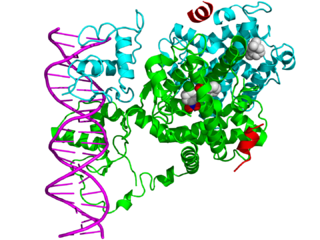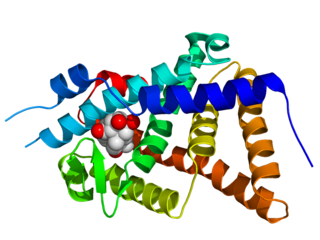Juvenile hormones (JHs) are a group of acyclic sesquiterpenoids that regulate many aspects of insect physiology. The first discovery of a JH was by Vincent Wigglesworth. JHs regulate development, reproduction, diapause, and polyphenisms.

20-Hydroxyecdysone is a naturally occurring ecdysteroid hormone which controls the ecdysis (moulting) and metamorphosis of arthropods. It is therefore one of the most common moulting hormones in insects, crabs, etc. A phytoecdysteroid produced by various plants, including Cyanotis vaga, Ajuga turkestanica and Rhaponticum carthamoides, its purpose is presumably to disrupt the development and reproduction of insect pests. In arthropods, 20-hydroxyecdysone acts through the ecdysone receptor. Although mammals lack this receptor, 20-hydroxyecdysone affects mammalian biological systems. 20-Hydroxyecdysone is an ingredient of some supplements that aim to enhance physical performance. In humans, it is hypothesized to bind to the estrogen receptor beta (ERβ) protein-coding gene.

Rhaponticum carthamoides, synonym Leuzea carthamoides, is a species of herbaceous perennial plant in the family Asteraceae. It is known as maral root or rhaponticum. It inhabits the sub-alpine zone as well as alpine meadows. It can be found growing wild in Southern Siberia, Kazakhstan, the Altay region, and Western Sayan Mountains. Maral root is widely cultivated throughout Russia and Eastern Europe. This plant derives its traditional name maral root (maralu) from the maral deer that fed on it.
In biology, cell signaling is the process by which a cell interacts with itself, other cells, and the environment. Cell signaling is a fundamental property of all cellular life in prokaryotes and eukaryotes.

In the field of molecular biology, nuclear receptors are a class of proteins responsible for sensing steroids, thyroid hormones, vitamins, and certain other molecules. These intracellular receptors work with other proteins to regulate the expression of specific genes, thereby controlling the development, homeostasis, and metabolism of the organism.
Phytotoxins are substances that are poisonous or toxic to the growth of plants. Phytotoxic substances may result from human activity, as with herbicides, or they may be produced by plants, by microorganisms, or by naturally occurring chemical reactions.

Cholesterol 7 alpha-hydroxylase also known as cholesterol 7-alpha-monooxygenase or cytochrome P450 7A1 (CYP7A1) is an enzyme that in humans is encoded by the CYP7A1 gene which has an important role in cholesterol metabolism. It is a cytochrome P450 enzyme, which belongs to the oxidoreductase class, and converts cholesterol to 7-alpha-hydroxycholesterol, the first and rate limiting step in bile acid synthesis.

Ecdysteroids are arthropod steroid hormones that are mainly responsible for molting, development and, to a lesser extent, reproduction; examples of ecdysteroids include ecdysone, ecdysterone, turkesterone and 2-deoxyecdysone. These compounds are synthesized in arthropods from dietary cholesterol upon metabolism by the Halloween family of cytochrome P450s. Phytoecdysteroids also appear in many plants mostly as a protection agents against herbivore insects.
Phytoecdysteroids are plant-derived ecdysteroids. Phytoecdysteroids are a class of chemicals that plants synthesize for defense against phytophagous insects. These compounds are mimics of hormones used by arthropods in the molting process known as ecdysis. When insects eat the plants with these chemicals they may prematurely molt, lose weight, or suffer other metabolic damage and die.

Obesogens are certain chemical compounds that are hypothesised to disrupt normal development and balance of lipid metabolism, which in some cases, can lead to obesity. Obesogens may be functionally defined as chemicals that inappropriately alter lipid homeostasis and fat storage, change metabolic setpoints, disrupt energy balance or modify the regulation of appetite and satiety to promote fat accumulation and obesity.
Ecdysone 20-monooxygenase (EC 1.14.99.22) is an enzyme that catalyzes the chemical reaction

The enzyme juvenile hormone esterase (EC 3.1.1.59, systematic name methyl-(2E,6E,10R)-10,11-epoxy-3,7,11-trimethyltrideca-2,6-dienoate acylhydrolase, JH esterase) catalyzes the hydrolysis of juvenile hormone:

The ecdysone receptor is a nuclear receptor found in arthropods, where it controls development and contributes to other processes such as reproduction. The receptor is a non-covalent heterodimer of two proteins, the EcR protein and ultraspiracle protein (USP). It binds to and is activated by ecdysteroids. Insect ecdysone receptors are currently better characterized than those from other arthropods, and mimics of ecdysteroids are used commercially as caterpillar-selective insecticides.

The halloween genes are a set of genes identified in Drosophila melanogaster that influence embryonic development. All of the genes code for cytochrome P450 enzymes in the ecdysteroidogenic pathway (biosynthesis of ecdysone from cholesterol). Ecdysteroids such as 20-hydroxyecdysone and ecdysone influence many of the morphological, physiological, biochemical changes that occur during molting in insects.
The prothoracic glands are either of a pair of endocrine glands located in the prothorax of certain insects that regulate molting. They have an ectodermal origin and secrete ecdysteroids, such as ecdysone and 20-hydroxyecdysone. They usually disappear in adults.
An insect growth regulator (IGR) is a chemical insecticide that kills insects indirectly by disrupting their life cycles. The term was initially proposed to describe the effects of juvenile hormone analogs. Although the term "insect growth disruptor" more accurately describes the actions of IGRs, it did not become widely used. IGRs encompass chemical classes with three modes of action : juvenile hormone analogs, chitin synthesis inhibitors, and ecdysone receptor agonists.

Tebufenozide is an insecticide that acts as a molting hormone. It is an agonist of the ecdysone receptor that causes premature molting in larvae. It is primarily used against caterpillar pests. It belongs to the class of diacylhydrazines.
In molecular biology mir-14 microRNA is a short RNA molecule. MicroRNAs function to regulate the expression levels of other genes by several mechanisms.

The diacylhydrazines, also known as bisacylhydrazines (BAHs) or dibenzoylhydrazines are appropriately substituted derivatives of dibenzoyl hydrazine. They do not immediately kill the insect, but produces premature unsuccessful moulting, which then causes the death of the insect. BAHs thus belong to the class of insect growth regulators.
Cytochrome P450, family 305, also known as CYP305, is an animal cytochrome P450 family found in insect genome. The first gene identified in this family is the CYP305A1 from the Drosophila melanogaster.










